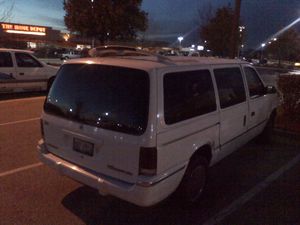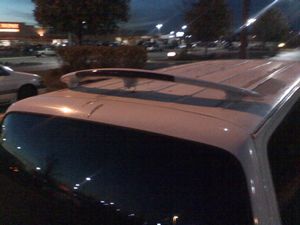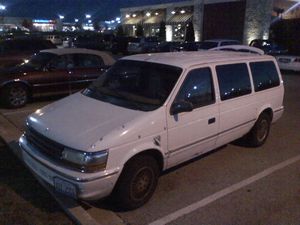















Chrysler Grand Voyager
|
|---|
|
| Topic Navigation |
|---|
|
Wikipedia: Plymouth Voyager
Page Sections History Reference Desk Documents Photographs |
History
The following section is an excerpt from Wikipedia's Plymouth Voyager page on 9 August 2016, text available via the Creative Commons Attribution-ShareAlike 3.0 Unported License.
From 1984-2000, Plymouth marketed a minivan as the Voyager, simultaneously introduced with the Dodge Caravan and marketed over four generations in short-wheelbase (SWB) (1984-2000) and long-wheelbase (LWB)(1987-2000) variants — the latter as the Plymouth Grand Voyager. After model year 2000, Chrysler (at the time DaimlerChrysler AG) discontinued its Plymouth division, and the Voyager and Grand Voyager were marketed as the Chrysler Voyager (2001–2003). The Plymouth Voyager was marketed as Chryslers in Mexico prior to that.
Combined with its rebadged variants, the Chrysler minivans rank as the 13th best-selling automotive nameplate worldwide.
Minivan background
Generation I (1984–1990)
In 1984, Chrysler marketed the rebadged Plymouth variant of its new minivan as the Voyager, using the Chrysler's S platform, derived from the K-platform (Plymouth Reliant and Dodge Aries). The Voyager shared components with the K-cars including portions of the interior, e.g., the Reliant's instrument cluster and dashboard controls, along with the K-platform front-wheel drive layout and low floor, giving the Voyager a car-like ease of entry. The Voyager was on Car and Driver magazine's Ten Best list for 1985.
For 1987 the Voyager received minor cosmetic updates as well as the introduction of the Grand Voyager, which was built on a longer wheelbase adding more cargo room. It was available only with SE or LE trim.
First-generation Voyager minivans were offered in three trim levels: an unnamed base model, mid-grade SE, and high-end LE, the latter bearing simulated woodgrain paneling. A sportier LX model was added in 1989, sharing much of its components with the Caravan ES.
Safety features included 3-point seat belts for the front two passengers and lap belts for rear passengers. Standard on all Voyagers were legally mandated side-impact reinforcements for all seating front and rear outboard positions. Safety features such as airbags or ABS were not available.
Original commercials for the 1984 Voyager featured magician Doug Henning as a spokesperson to promote the Voyager "Magic Wagon's" versatility, cargo space, low step-in height, passenger volume, and maneuverability. Later commercials in 1989 featured rock singer Tina Turner. Canadian commercials in 1990 featured pop singer Celine Dion.
Generation II (1990–1995)
The Plymouth Voyager was modified for 1991 with new sheet metal. The S platform was still used, though renamed the "AS platform". These were the last Voyagers that were derived from the Chrysler K platform.
Trim levels were carried over from the previous generation. 1991 Voyagers were available in base, mid-grade SE, high-end LE, and high-end sporty LX. The LX which was available only on short-wheelbase Voyagers, was marketed as a sport-luxury minivan and came with the most standard equipment including alloy wheels, fog lamps, and wide array of power-operated features.
In later years various trim packages were offered on SE models. The "Sport Wagon" package available from 1993–1995 featured accent color (gray) bumpers and molding, fog lamps, and special aluminum wheels. The "Rallye" package offered in 1995, took the place of the departed LX model. It was more luxury-oriented, with lower body two-tone paint — regardless of upper body color, the lower body was painted "Driftwood Beige" — silver aluminum wheels, and special badging. The font first used for the Rallye's badging was adopted for all of Plymouth's badging from 1996 onward.
Interiors were more differentiated in this generation than on the first with a redesigned dashboard for 1994 featured a passenger-side front airbag. and a seating package, marketed as "Quad Command" seating package, available on SE, LE, and LX models. Quad command replaced the 2nd row bench with two individual bucket seats with a center aisle to the 3rd row bench. Interior options varied with trim levels and packages. Cloth seating was standard on all models; leather seating was a standalone extra-cost option on LE and LX models.
Only badging and minor cosmetics differentiated the Voyager from its Dodge Caravan rebadged variant. The Chrysler Town & Country shared the Voyager's headlamps and taillights along with its own chrome waterfall grille.
Generation III (1996–2000)
The 1996 Plymouth Voyager was completely redesigned from the ground up. Gone were its K-car underpinnings and architecture, replaced with more modern components and Chrysler's acclaimed cab-forward design. The third generation redesign used the Chrysler NS platform and included a driver's-side sliding door, a minivan first. The Voyager was on Car and Driver magazine's Ten Best list for 1996 and 1997.
As part of Chrysler's new corporate strategy to better focus the Plymouth brand on entry-level vehicles, U.S. market third generation Voyagers and Grand Voyagers were mostly available in base trim and better-equipped SE models. Although export markets continued to receive the LE model, the "Rallye", originally a trim package on SE and LE models in 1995, became a high-end standalone trim level for this generation, replacing the LE for the US market. A Rallye option package continued to be available on SE model. It was replaced by the "Expresso" for 1998. As with the Rallye, the Expresso was either a package for the SE or a stand-alone model to replace the LE. Expresso models did feature their own optional higher-grade cloth seating. Export Voyager LEs were equipped similarly to the Chrysler Town & Country LX, which was sold in the U.S. and Mexico, but not Canada. Voyager LE featured a standard Infinity sound system, a power driver's seat, deluxe cloth seating as found on standalone Rallye and Expresso models (leather was optional), and either steel wheels with covers or alloy wheels, both shared with the Town & Country LX, among other features. All North American Voyagers of the third generation were not available with front fog lights.
Base Voyagers and Voyager SEs were easily distinguished by their body-side moldings. Base models used a narrow accent color strip and SE models used a wide accent color strip with a "Plymouth" badge above it on either front door. Rallye and Expresso models used the SE's body-side molding with their own badge in the place of the Plymouth one. Export-market LEs used the base model's narrow accent color molding combined with a full accent color effect on the lower portion of the doors. The vinyl woodgrain-appearance side paneling was no longer available, as the new side sheetmetal was no longer flat.
Third generation Voyagers introduced a new system of rear seats to simplify installation, removal, and re-positioning— marketed as "Easy-Out Roller Seats". All Voyagers and Grand Voyagers were equipped with this feature. When installed, the 2nd and 3rd row seats (either bucket or bench seats) were latched to floor-mounted strikers. When unlatched, eight rollers lifted each seat, allowing it to be rolled fore and aft. Tracks had locator depressions for rollers, thus enabling simple installation. Ergonomic levers at the seatbacks released the floor latches single-handedly without tools and raised the seats onto the rollers in a single motion. Additionally, seatbacks were designed to fold forward. Seat roller tracks were permanently attached to the floor and seat stanchions were aligned, facilitating the longitudinal rolling of the seats. Bench seat stanchions were moved inboard to reduce bending stress in the seat frames, allowing them to be lighter.
Reference Desk
The Crittenden Automotive Library's "Reference Desk" is a collection of materials that cannot be shared due to copyright restrictions. Information from these resources, however, can be shared. Go to the Reference Desk page for more information.
| Type | Title |
|---|---|
2002  Book Book | Dodge Caravan, Plymouth Voyager & Chrysler Town & Country 1996 thru 2002 Haynes Repair Manual by L. Alan LeDoux and John H. Haynes; Haynes |
 |
Modified w/spoiler Photo ©2010 Bill Crittenden View photo of Plymouth Grand Voyager Modified w/spoiler - 344KB |
 |
Modified w/spoiler Photo ©2010 Bill Crittenden View photo of Plymouth Grand Voyager Modified w/spoiler - 350KB |
 |
Modified w/spoiler Photo ©2010 Bill Crittenden View photo of Plymouth Grand Voyager Modified w/spoiler - 407KB |
